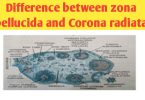Differences between Leading and Lagging strand, I hi guys in this article we know about what is leading and lagging strand. And also know about differences between these two.
The enzyme DNA polymerase can polymerize the nucleotides only in 5′- 3′ direction. DNA polymerase is responsible for the template directed condensation of deoxyribonucleotide triphosphate. Synthesis of new complementary strand proceeds from the 3′ hydroxyl group (OH) of the Primer causing extension or growth in 5′-3′ direction. Because two strand of DNA are in antiparallel direction the two strand have to be synthesized by growth of growing in opposite direction.
The addition of deoxyribonucleotide is done by DNA polymerase in presence of ATP. The enzyme synthesise a new strand in continuous piece in 5′-3′ direction and is called leading strength. On other strand of DNA The enzymes form DNA fragment in a small piece again in 5′- 3′ direction initiating from RNA primer. The primer is formed with the help of Primer enzyme the small segment are called okazaki fragments, they are joined together to produce a continuous daughter strand with the help of DNA ligase joining this strand is called lagging strand.
What is leading strand? The DNA polymerase enzyme synthesise a new strand in continuous piece in 5′-3′ direction and is called leading strand. The template DNA strand that is in 5′-3′ direction form complementary DNA in 3′-5′ direction starting from 3 end of template strand in inward direction continuous forming new continuous strand that is leading strand.
What is lagging strand? The DNA polymerase enzyme synthesise a new strand in discontinuous piece in 5′-3′ direction and is called lagging strand. Formation of lagging strand is starting from origin of replication in 5′-3′ direction discontinuously, form a small piece of DNA fragment known as okazaki fragments attached with RNA primer, they all are joined together to produce continuous daughter strand with the help of DNA ligase enzyme forming lagging strand.
What is difference between leading strand and lagging strand? The DNA polymerase enzyme synthesise a new strand in continuous piece in 5′-3′ direction and is called leading strand, it requires only one primer to initiate the growth and DNA ligase enzyme is not required and it formed continuously as single fragment. However The DNA polymerase enzyme synthesise a new strand in discontinuous piece in 5′-3′ direction and is called lagging strand, in the beginning it is formed in form of a small fragment called okazaki fragments, every fragments require separate RNA primer to initiate and require DNA ligase enzyme to join all the fragments.
Differences between leading and lagging strand
What is difference between leading strand and lagging strand? The DNA polymerase enzyme synthesise a new strand in continuous piece in 5′-3′ direction and is called leading strand, it requires only one primer to initiate the growth and DNA ligase enzyme is not required and it formed continuously as single fragment. However The DNA polymerase enzyme synthesise a new strand in discontinuous piece in 5′-3′ direction and is called lagging strand, in the beginning it is formed in form of a small fragment called okazaki fragments, every fragments require separate RNA primer to initiate and require DNA ligase enzyme to join all the fragments.

Differences between Leading and Lagging strand
Now we briefly explain the difference between leading and lagging strand in following to the point:-
Leading strand:-
1) it is formed continuously in 5′-3′ direction in single fragment
2) it requires only one primer to initiate the growth
3) DNA ligase enzyme is not required to this strand
4) direction of growth of leading strand is 5′-3′.
Lagging strand:-
1) in the beginning it is formed in the form of a small fragment called okazaki fragments
2) every fragment requires separate RNA primer to initiate
3) it is required DNA ligase enzyme to join DNA fragments
4) of complete strand it is 3′-5′ in direction however for okazaki fragment it is in 5′- 3′ direction.







Leave a Comment